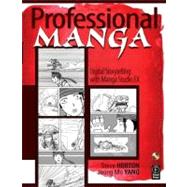
Note: Supplemental materials are not guaranteed with Rental or Used book purchases.
Purchase Benefits
Looking to rent a book? Rent Professional Manga: Digital Storytelling with Manga Studio EX [ISBN: 9780240810287] for the semester, quarter, and short term or search our site for other textbooks by Horton; Steve. Renting a textbook can save you up to 90% from the cost of buying.
| Professional Manga | |
| Short Table of Contents and Synopses | |
| The Building Blocks of Manga | |
| Line Art | |
| Here are tips from the artist on how to draw lines smoothly | |
| Also, heres some instruction on how to draw thicker lines in the foreground and thinner lines in the background | |
| Shading & Textures: Basics This is an introduction to shading as a replacement for color | |
| Most manga is black and white and uses grayscale tones and shading to give weight and balance to the elements of a page | |
| Manga Studio comes with premade textures, but the best artists create their own | |
| Heres how to do so and how to apply a texture to an element | |
| Shading & Textures: Advanced Its important to know how to use the light source, the camera and other directing knowledge to help you shade a scene properly | |
| Also, its critical to shade at a specific resolution so that details and moire patterns dont develop when the page is reduced for print | |
| Also, dont overuse textures | |
| Sometimes none are called for and the art needs to be left open | |
| Speed Lines In a lot of manga, characters can move fast or express a lot of movement within the space of a single panel | |
| Since a comic panel is a single snapshot in time, how best to express that movement? One solution that manga partakes in frequently is speed lines | |
| Speed lines can be straight or circular, parallel or concentric, depending on the kind of motion that needs to be expressed in a panel | |
| Speed lines are also used when a character comes to a realization or epiphany | |
| Heres how to correctly apply the right speed lines to your panel | |
| Manga Studio has this functionality built in, but advanced users will want to tweak the settings or even create the lines manually | |
| Like the other techniques, its critical not to overuse them | |
| One panel per page at most is a good guideline | |
| Pick the fastest or most critical scene on the page and go for it! | |
| Blurring An alternative or a companion to speed lines, blurring is another way to show motion | |
| Since the advent of photoshop, blurring and other digital tricks have become more prevalent in manga | |
| Heres how its done | |
| Backgrounds Beginning manga artists often lack the skills to render backgrounds well | |
| These artists want to skip straight to the characters and the action and skimp on buildings and other boring stuff | |
| This is a pitfall | |
| Backgrounds are just as important as the rest of the page, and its important to both concentrate on them and know how to render them correctly in Manga Studio | |
| Technology Theres a juxtaposition between the simplicity of a manga character and the complexity of the technology that might exist in their world | |
| The characters are meant to be iconic, but the technology is specific | |
| This is often where most of the detail and time is spent | |
| Heres how to make technology look like it is supposed to | |
| Sound Effects and Lettering Special effects can often depend on the creators country of origin | |
| Despite the language in which the book might be translated or presented, the sound effects stay in that original language | |
| Brian Yang prefers to render sound effects in Korean | |
| Korean characters look cool and different when drawn large | |
| Also, manga sound effects tend to morph and change with the action, often becoming part of the scene! Here are some tricks for creating and manipulating SFX so they stand out | |
| Lettering is often glossed over in much translated manga to its detriment | |
| There are a few simple tips to know when lettering manga | |
| Here they are, and heres how to pick a good font and letter the right way | |
| Center Section: Manga Short Story The Other Side of the Tracks This is an original creation of the author, written by Steve Horton and drawn by Brian Yang | |
| This manga uses all the storytelling and Manga Studio techniques used throughout this book and acts as a coda for all the lessons learned | |
| A high-res version | |
| Table of Contents provided by Publisher. All Rights Reserved. |
The New copy of this book will include any supplemental materials advertised. Please check the title of the book to determine if it should include any access cards, study guides, lab manuals, CDs, etc.
The Used, Rental and eBook copies of this book are not guaranteed to include any supplemental materials. Typically, only the book itself is included. This is true even if the title states it includes any access cards, study guides, lab manuals, CDs, etc.